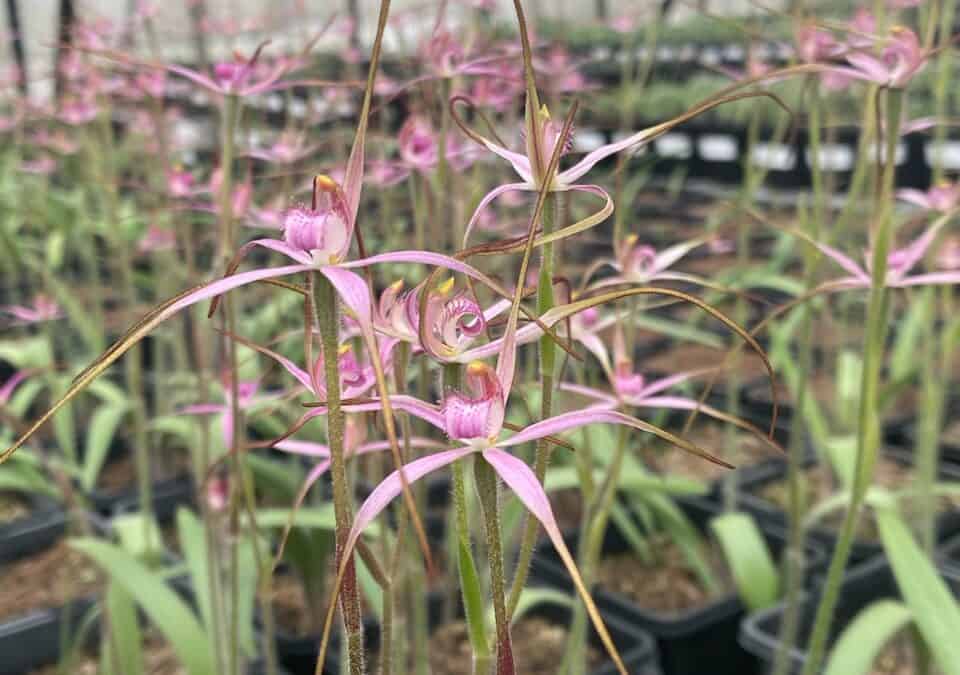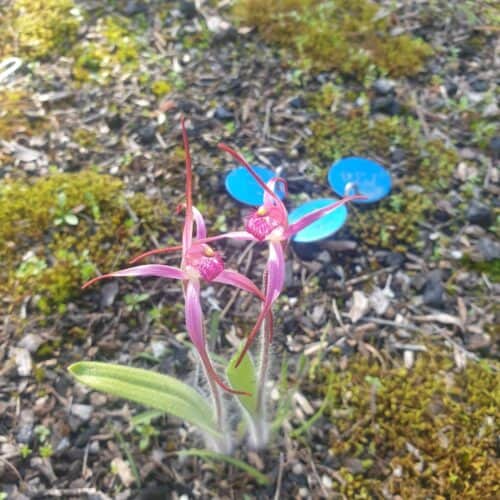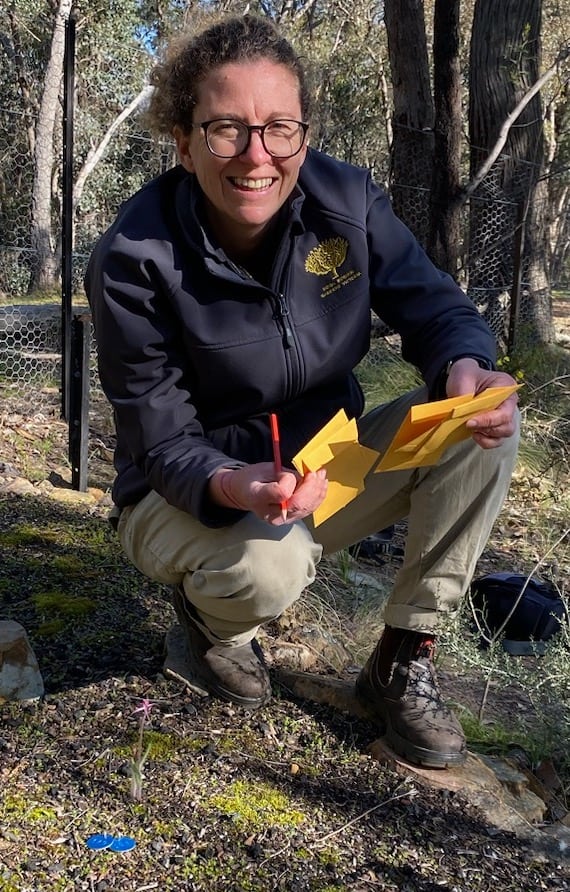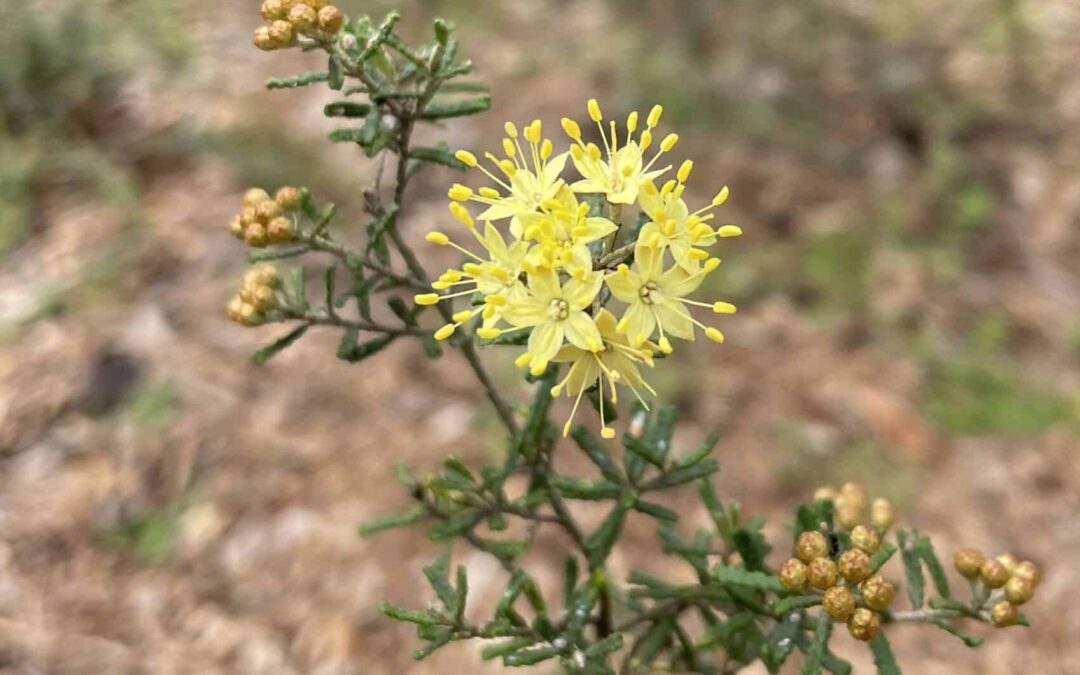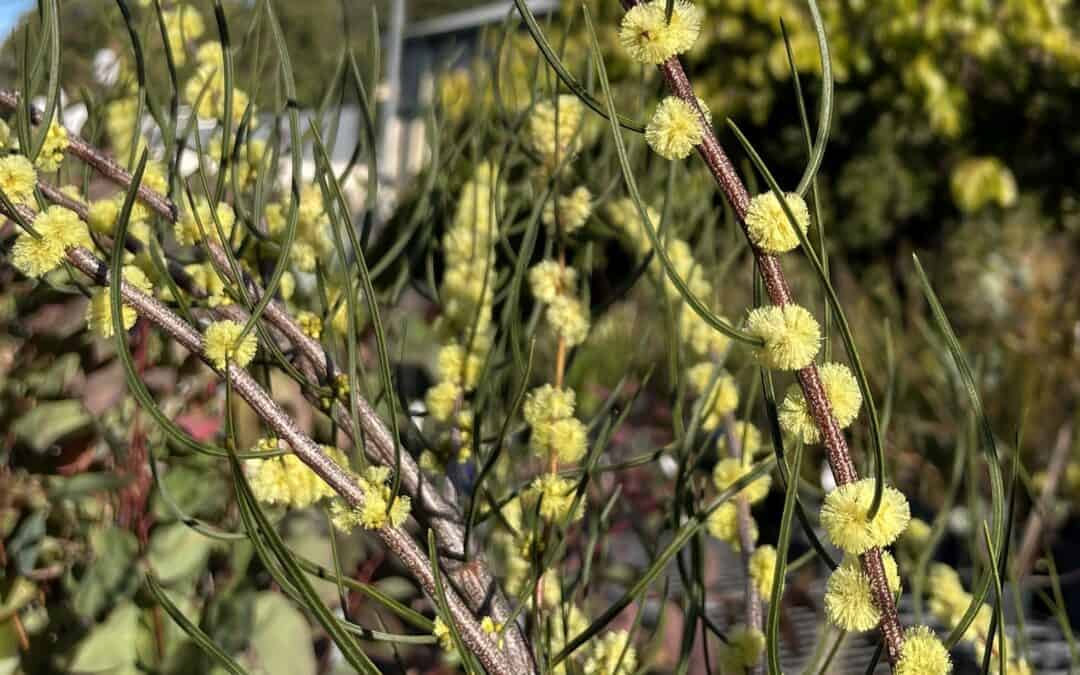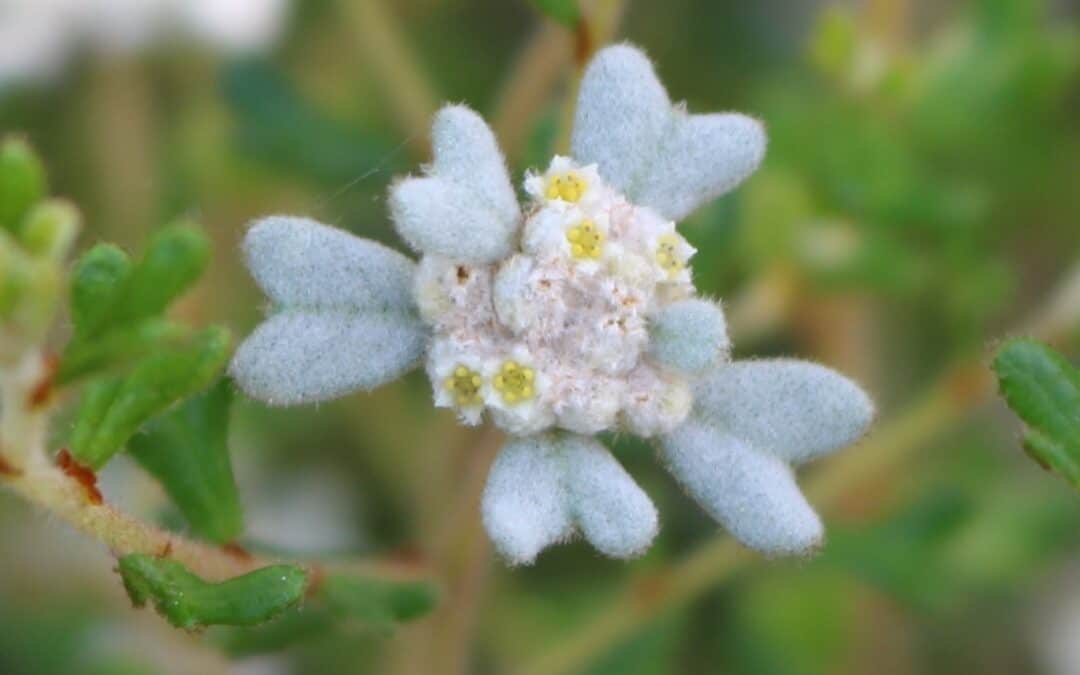
Oct 13, 2023 | News
This rose-pink spider orchid is critically endangered and restricted to only a few sites in the north-east suburbs of Melbourne. Royal Botanic Gardens Victoria (RBGV) scientists have been busy surveying remnant and translocated populations and collecting genetic samples as part of the ‘Preventing the extinction of Victoria’s threatened flora program’. The genetic analysis will help guide strategic cross-pollination to produce more genetically diverse seed both for long term storage and to supply new plants for further reintroductions into the wild.

Supplied: Royal Botanic Gardens Victoria
Pollination surveys are also underway, with scientists using nursery grown plants to attract the pollinator, a native bee in the genus Leioproctus. Identifying the presence of the key pollinator in potential translocation sites is a crucial step in site selection suitability, as Caladenia rosella plants will not set seed and regenerate at a site if it is absent.

Supplied: Royal Botanic Gardens Victoria
The ‘Preventing the extinction of Victoria’s threatened flora’ project is led by Royal Botanic Gardens Victoria in partnership with La Trobe University, Australian Network for Plant Conservation, DEECA, Trust for Nature, ENVITE, Bairnsdale & District Field Naturalists Club, Friends of the Grampians Gariwerd, Wimmera CMA, Nillumbik Shire, Halls Gap Botanic Gardens and the Australasian Native Orchid Society Victorian Branch.
This project is funded by the Victorian Government Department of Energy, Environment and Climate Action Nature Fund.

Sep 22, 2023 | News
Previously recorded throughout much of the Mallee region of western Victoria, the Mallee Phebalium, Phebalium glandulosum subsp. macrocalyx is now restricted to a few small populations south west of Swan Hill in north-western Victoria. There may be as few as 50 plants left in the wild in Victoria, and as such it is listed as Critically Endangered in Victoria under the Flora and Fauna Guarantee Act. The Mallee Phebalium is one of 24 threatened species that scientists and horticulture staff at the RBGV are working to protect as part of the Preventing the extinction of Victoria’s threatened flora project.
This small to medium shrub has small bright yellow flowers and prominently glandular leaves that are aromatic when crushed. Many species of Phebalium are grown as garden plants, however cultivation is generally by cuttings, as seeds are very difficult to germinate due to physical or chemical dormancy mechanisms. We currently do not know how to germinate the Mallee Phebalium, so part of the work by the RBGV will be collecting seeds and running germination trials to try to figure out how to make them grow. Seeds will then be placed in long-term storage in the Victorian Conservation Seedbank and plants grown in a living collection at the RGBV to insure against loss of this species in the wild.
This research is funded by DEECA Victoria’s Nature Fund. The ‘Preventing the extinction of Victoria’s threatened flora’ project is led by Royal Botanic Gardens Victoria in partnership with La Trobe University, Australian Network for Plant Conservation, DEECA, Trust for Nature, ENVITE, Bairnsdale & District Field Naturalists Club, Friends of the Grampians Gariwerd, Wimmera CMA, Nillumbik Shire, Halls Gap Botanic Gardens and the Australasian Native Orchid Society Victorian Branch.
Article Image: Mallee Phebalium (Phebalium glandulosum subsp. macrocalyx) – Photo credit: Andre Messina

Aug 31, 2023 | News
A behind the scenes look at the small conservation collection of Acacia phasmoides (Phantom wattle), which has just started flowering in the Royal Botanic Gardens Victoria (RBGV) nursery. The Phantom wattle only occurs on Pine Mountain, in northeast Victoria, and Woomargama in NSW. This species is federally listed as Vulnerable and is at risk of local extinction due to unpredictable natural threats, including severe floods or fire.
RBGV conservation geneticists are analysing genetic data to guide ex situ conservation of the Phantom wattle, which will include collections for the Victorian Conservation Seedbank and propagation of additional plants to build the conservation collection.
Holding seed and plants ex situ acts as insurance against the loss of wild populations and forms part of the Preventing the extinction of Victoria’s threatened flora project. RBGV botanists will be joined by members of the local community when undertaking surveys and collecting the plants.
This research is funded by DEECA’s Victoria’s Nature Fund. The ‘Preventing the extinction of Victoria’s threatened flora’ project is led by Royal Botanic Gardens Victoria in partnership with La Trobe University, Australian Network for Plant Conservation, DEECA, Trust for Nature, ENVITE, Bairnsdale & District Field Naturalists Club, Friends of the Grampians Gariwerd, Wimmera CMA, Nillumbik Shire, Halls Gap Botanic Gardens and the Australasian Native Orchid Society Victorian Branch
Image: Acacia phasmoides growing in the RBGV nursery. (Laura Simmons)

Jul 28, 2023 | News
Thanks to funding from DEECA Victoria’s Nature Fund,
Royal Botanic Gardens Victoria will be leading research to conserve 24 threatened Victorian plant species as part of the ‘Preventing the extinction of Victoria’s threatened flora’ project. Stay tuned over the next year to hear more about the incredible plants being conserved for future generations.
One of these plants, and the first to be featured over the next 12 months, is
Spyridium furculentum (forked spyridium).

Considered Critically Endangered in Victoria under the Flora and Fauna Guarantee Act, this rare species is endemic to heathy mallee in western Victoria – where it is only known from a few locations.
Forked spyridium is a shrub that grows to approximately 1.6 m tall, and the young branches are covered with star-shaped (stellate) hairs giving them a soft, furry appearance.
Ahead of field work later this year when populations will be surveyed and samples collected to characterise the genetic diversity of those populations, scientists are investigating seed viability and germination of seed collections held in the Victorian Conservation Seedbank (VCS) at Royal Botanic Gardens Victoria.
The VCS holds collections of over 880 rare and threatened Victorian plant species for long-term conservation and this includes nine collections of Spyridium furculentum made since 2004. Like many species in the family Rhamnaceae, seeds of forked spyridium have a hard seed coat which acts as a physical barrier to water uptake and germination, so a dry heat treatment will be used to break this physical dormancy and enable germination. Seedlings will then be grown on to bolster populations in the wild.
This project is led by Royal Botanic Gardens Victoria in partnership with La Trobe University, Australian Network for Plant Conservation, DEECA, Trust for Nature, ENVITE, Bairnsdale & District Field Naturalists Club, Friends of the Grampians Gariwerd, Halls Gap Botanic Gardens and the Australasian Native Orchid Society Victorian Branch.
Image: Jo Lynch

Jun 1, 2023 | News
| The ANPC is pleased to announce that we will be collaborating with the Royal Botanic Gardens Victoria, La Trobe University and various other partners over the next 3 years on this Victoria-wide project. Funded by the Victoria Government’s Nature Fund program, the project aims to prevent the extinction of 24 endangered or critically endangered Victorian plants. Stay tuned for future project updates! |
